Distribution of Artlantis has come to an end. However, perpetual license holders may continue to use the software and download previous versions from our website whenever needed.
If you are seeking robust visualization or rendering software to replace Artlantis in your Archicad workflow, we have got you covered with native and external solutions such as AI Visualizer, MAXON’s Cinerender/Redshift, Twinmotion, D5 Render, Cinema 4D, Enscape, and others. Click here to learn more.
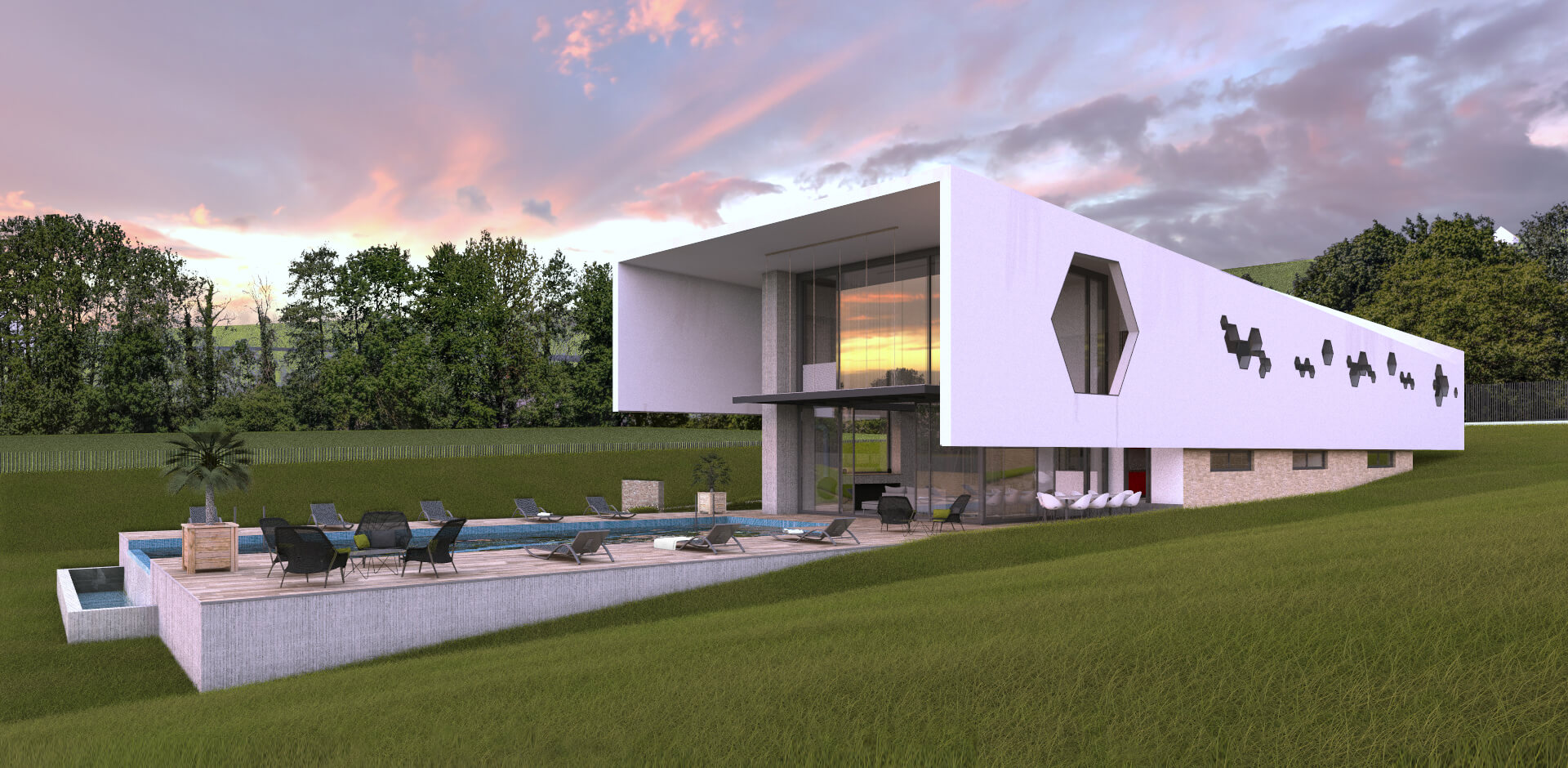
 Artlantis
Artlantis
A pioneer in VR imagery, Artlantis has conquered nearly 100,000 architects, interior designers, landscapers, urban planners, and space planners…in more than 110 countries. A CPU-based application, Artlantis is used by experts, advanced users and beginners alike, to simulate, present and communicate their ideas with striking photo-realism.
Artlantis 2021 enters the world of Open BIM with IFC import, offers a new easy interface with various LUTs and a brand new MediaStore.
Interface and
connection
Unique and universal
Handling DXF, DWG, OBJ, FBX, and 3DS formats, Artlantis is compatible almost with all 3D modelers currently on the market.
IFC Import
Artlantis 2021 now imports the IFC format. This new performance, concerning the model’s geometry only, allows the Artlantis user to receive any model from an interlocutor using a modeler other than their own and, if necessary, to modify the design directly in their own working.
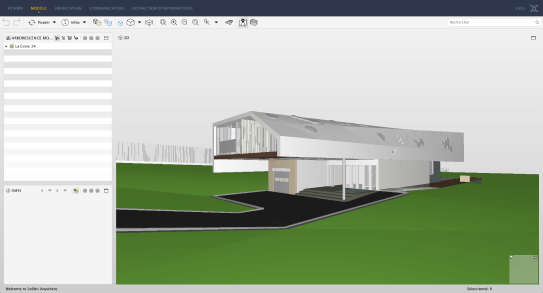
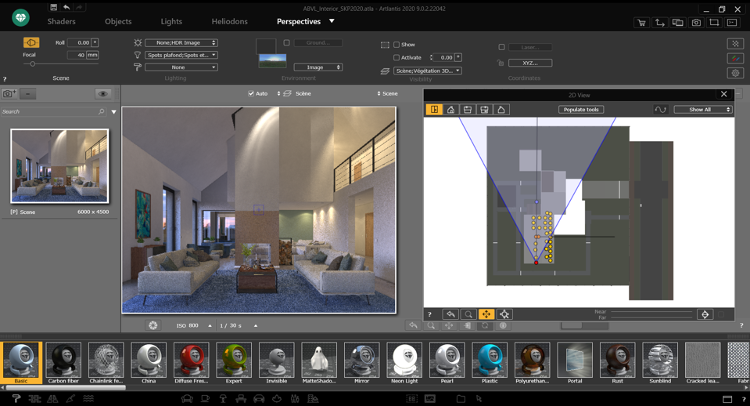
Easy Interface
Designed with an obvious and ergonomic interface, Artlantis is both easy and comfortable to learn and use. The new Easy interface in Artlantis 2021, more refined in terms of settings, has many predefined values and allows you to modify the settings by level such as “high, medium or low”. This approach makes it easier to understand settings, simplifies and speeds up scene-setting. Advanced users or beginners can use it according to their habits, technical knowledge, or preferences.
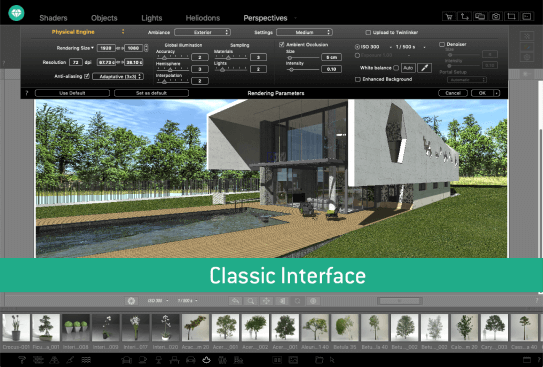
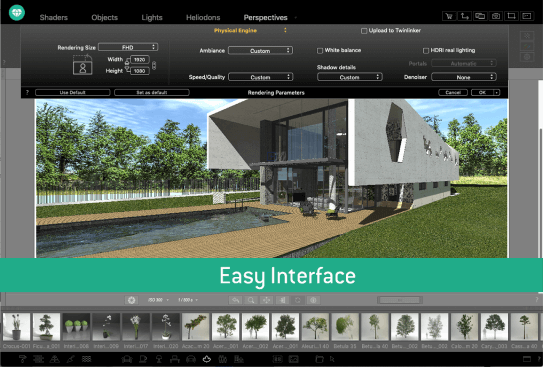
Views
2D view
In addition to the 3D preview, Artlantis has a 2D window to position cameras or edit sequences, making it easier to set up a panorama path to explore the project.
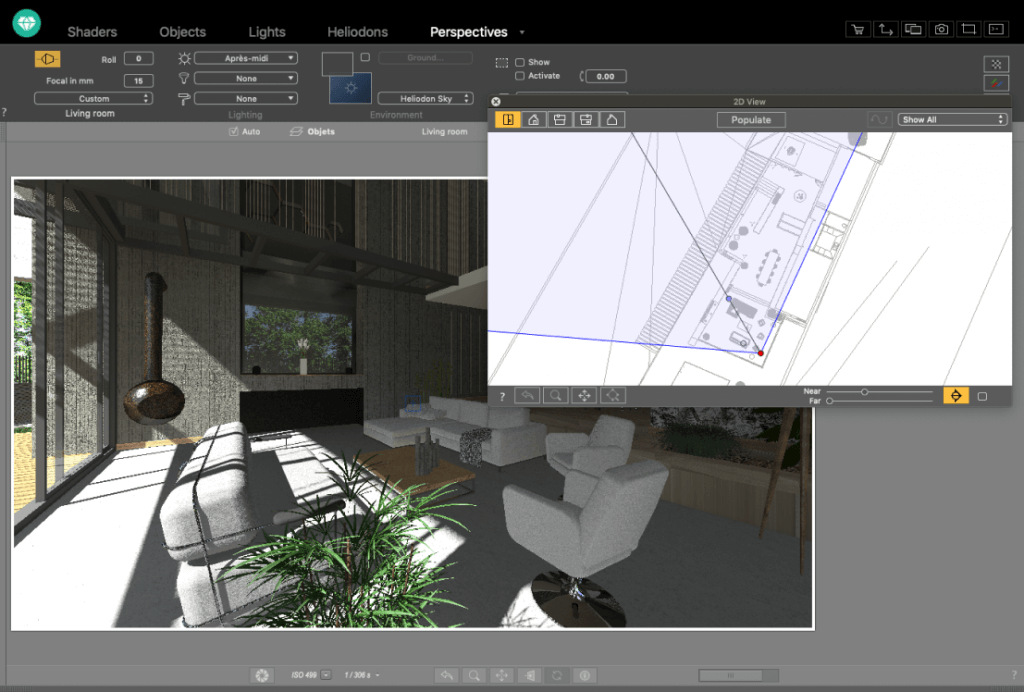
Viewpoints library
Artlantis makes it possible to save as many viewpoints, in both perspective and parallel projection, as you wish, and to edit them at any moment, adjust, set lights, the environment, or shaders.
Parallel views
Set parallel views (projections and cuts) in the dedicated inspector, based on the type of the projection (elevation, axonometry, top view), camera positioning, view width, or the definition of the cutting planes. A control bar allows you to edit the main settings of the project in its environment.
Real-time preview
The reputation and success of Artlantis are based primarily on its founding concept: a preview of the scene allowing users continuous control of each change. Right from opening a 3D scene, navigating, changing shaders and objects, lights, or 3D environment — all are immediately visible in the preview window.
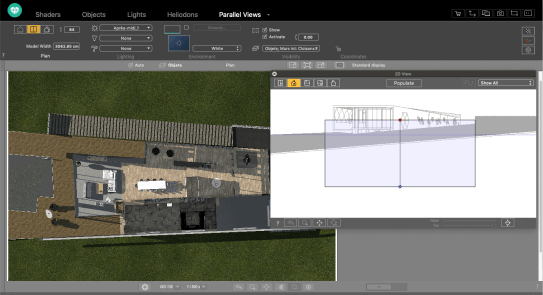
Media
Shaders & Textures
With a simple drag and drop from the catalog onto a surface from a scene, you can instantly dress it with the designated material and set its attributes like color, tint, opacity, reflection and diffraction, orientation and pattern scale, etc. For more realism, you can fine-tune the settings and change the outlook of the surface by modifying the reflectiveness, shininess, or bump.
Objects and 3D Characters
For setting up reality-like, vibrant scenes, Artlantis offers a fantastic object manager. You can manipulate objects in 3D or 2D. Their behavior depends on factors specific to the view (hierarchy, anchor, season) or their placement characteristics: such as a character always standing vertical or a wall lamp hanging perpendicular to the wall.
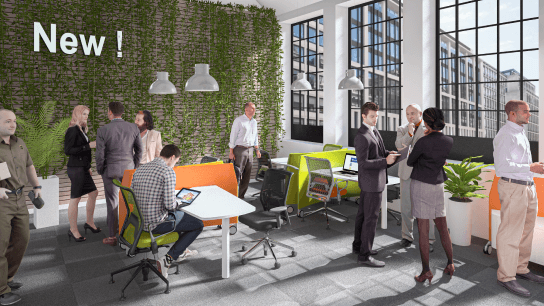
Integrated media catalog
Artlantis owes its fame to its rich and easy-to-use catalog: more than 1000 media intuitively organized to be explored in your 3D scenes directly.
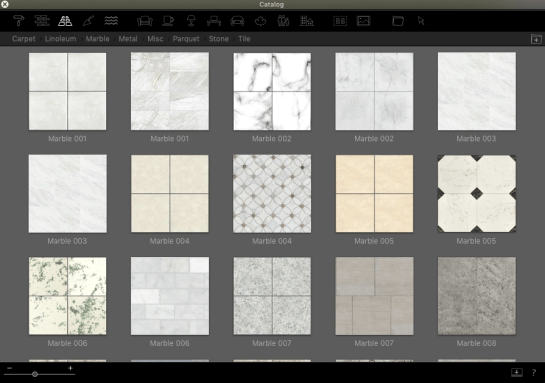
MediaStore
Thousands of other media (shaders, textures, materials, objects, characters, etc.) are available for purchase in the MediaStore, directly accessible from Artlantis. Artlantis’ native Media Converter assists you in transforming media from previous versions.
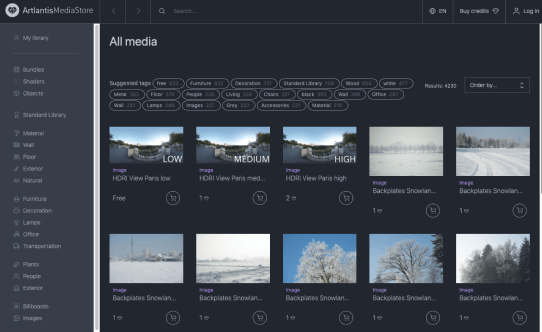
RAL Colors
Artlantis offers 243 codified colors and tints from RAL Effect, RAL Design, and RAL Classic color chart, the defining paint standards in architecture and building construction..

Vegetation tool and 3D grass
Plants, lawns, 3D trees, and grass are simple objects you can place by drag and drop. They also have a particular feature of adapting the density and shade of their foliage to the season.
Artlantis offers a specific tool to place vegetation objects individually by drop-drop or by zone.
The integrated Media catalog offers four new grass types and six updated types of 3D grass enhanced with different settings: adjust the color of the grass tufts, apply density variations.
Postcards
A Postcard is a snapshot of a scene saving all parameters assigned to materials (colors, shaders, and textures) for later use locally or shared. Similar to shaders, objects, or images you can also consider Postcards as media.
Global Illumination &
Lights
Global illumination
With Artlantis, it’s fast and easy to create light studies of a building based on the geographic orientation and location on the chosen date. Artlantis accurately evaluates the light energy for radiosity simulation based on irradiance calculations, adding realism to rendered images. A unique publication method, Twinlinker, allows you to create and share virtual visits of your projects online instantly and effortlessly. Export your Artlantis presentations (images and panoramas) to Twinlinker, then link them together to create virtual visits. Share them by email, social media, or on your website. Visit Twinlinker.com.
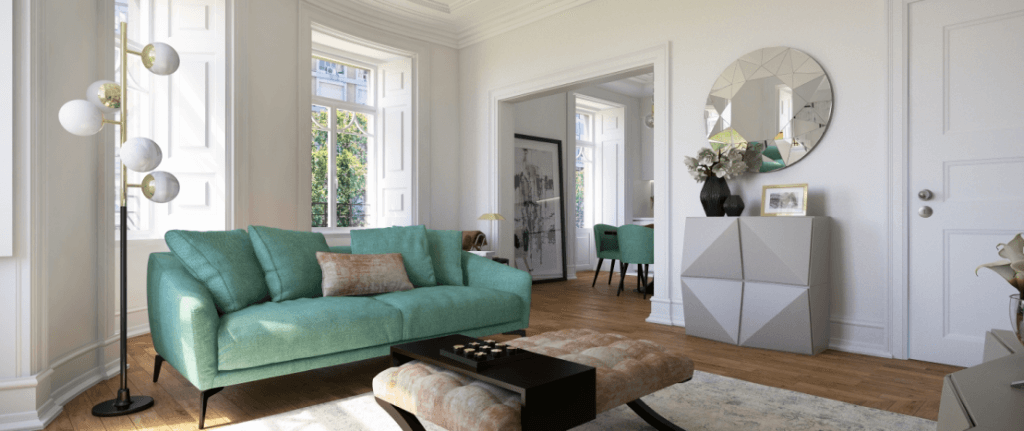
Lights
Artlantis has different light source types (spot, bulb, directional light, heliodon, sky) and effects (atmosphere, turbulence, diffraction, halo, depth of field) and manages transparent materials such as the impact of light on curtains. Soft shadows and blurs are easy to set with an interactive cursor. You can define as many Heliodons as you want to intervene on a particular object, image, or scene and act on the light rays and general atmosphere.
- Artificial lights with limitless positioning, orientation, color, intensity, or quantity.
- 8 native IES profiles, each of them comes with custom light intensity and radiosity. You also can import your own profiles as well as those from the manufacturers’ catalogs.
- Heliodons: these natural light sources can be customized depending on the time of year, day, hour and location (longitude and latitude). You can define as many ambiances and natural atmospheres as you require.
- HDRI background: turn on the HDRI image light to simulate the light emitted in the corresponding weather conditions to make your renderings more realistic.
- Neon shader: unlike spotlights, this is an emissive material to be applied on surfaces; you can set its power and color. It completes the artificial lights delivered with Artlantis and contributes to more realistic lighting.
Denoiser tool
Decrease, or even cancel, the noise in your renderings, typically produced by surface reflections. Want a little noise in your image? Decide for yourself to activate this option or not. The Denoiser tool analyzes the image’s pixels and reduces the noise.
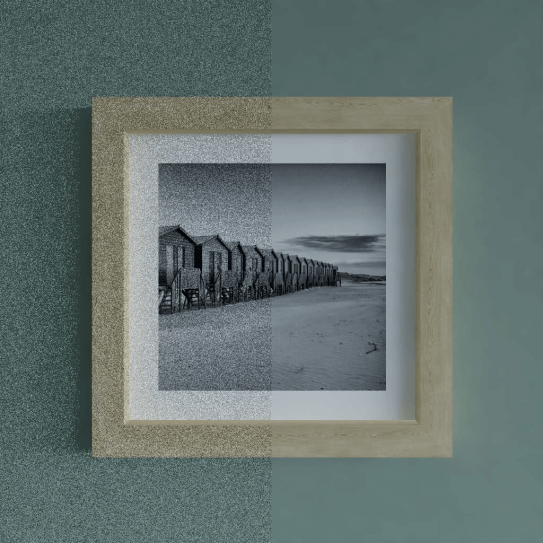
Portals tool
Portals: an optimization setting for managing light in Artlantis. When using low settings for a fast calculation of your renders, this feature improves your indoor scenes’ lighting and removes image noise.
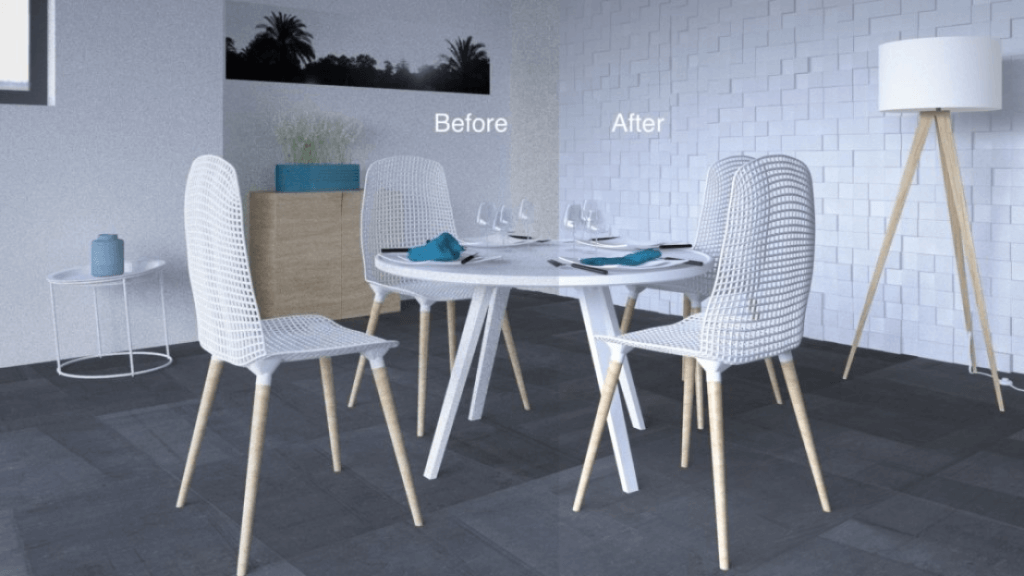
Still images &
animations
White model
This type of rendering allows you to automatically transform all surfaces of a scene — except for the transparent ones — into white material to appreciate the project volumes better. Lights used in the scene maintain their colors to create very elaborate atmospheres.
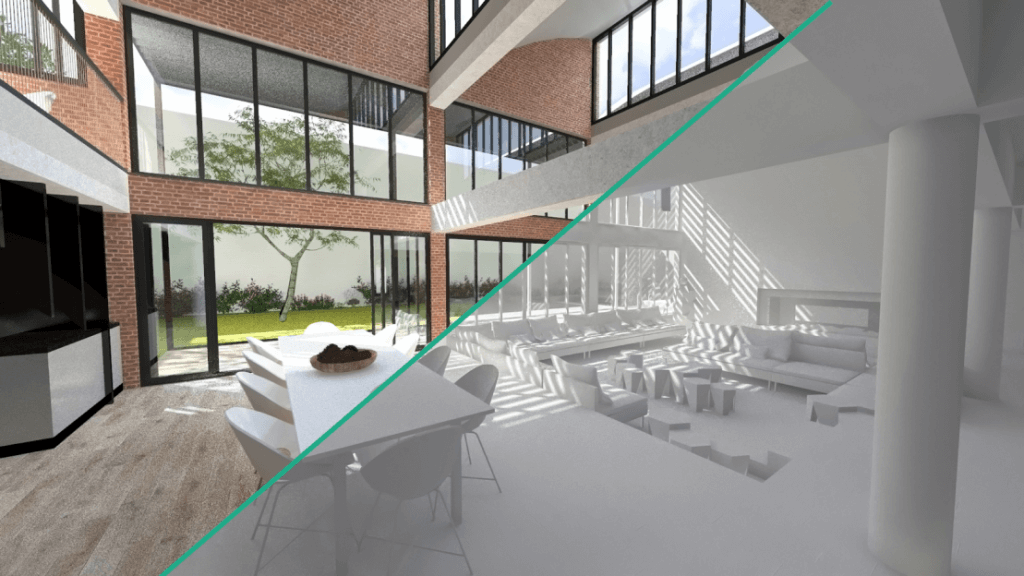
Site insertion
A unique feature of Artlantis, this essential tool allows simulating a building project in its future environment for building permits. The inspector guides you through the steps of space recognition, immediately displayed in the preview. A quick editor allows you to edit the foreground image without leaving Artlantis. Upon finishing the procedure, the final project is revealed in the preview window immediately.
White balance
The white balance automatically adjusts the color cast of an image, from the chosen reference color.
Ambient occlusion
Ambient occlusion simulates the shadows caused by objects blocking the ambient light in the indoor and outdoor scenes, which gives scenes more depth and relief and, therefore, more realism.
Adaptive antialiasing
Artlantis intelligent antialiasing adapts to delicate areas to improve image quality by reducing noise and aliasing contours.
Pre-defined settings
Choose from several pre-recorded modes (indoor, outdoor, low light) and different definitions (speed, medium, quality) to quickly obtain an optimal result!
Post-Processing
Apply different effects to the current view and set the rendering’s brightness, contrast, and color. Save time on giving an artistic touch, like grain, paint, or pastel; highlight contours directly in Artlantis.
LUTs
Artlantis 2021 integrates LUTs and filters to modify colorimetry and contrast to create a particular atmosphere or correct images in the preview and the final rendering. Artlantis 2021 offers a range of these filters by default. Should users wish to use any custom filter, they can import their preferred LUTs, available on various websites for free or as licensed .cube files.
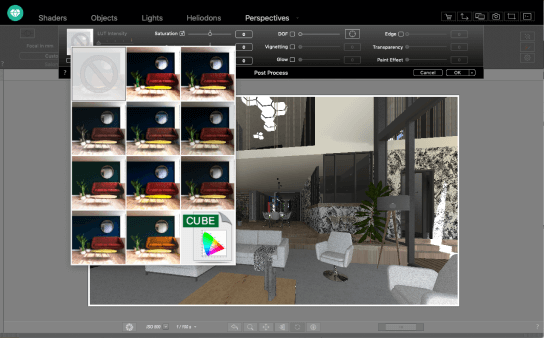
Animation
Objects, characters, clouds, atmospheric effects, shaders and textures, and light sources explore all components of the complete rendered scene.
Artlantis makes it possible to stage and design a film from one or more sequences edited and intuitively. Its integrated timeline allows you to define the tracking of the camera and/or the trajectory of objects and lights of the project; accelerate or slow down their movement; combine different sequences or panoramas; create and edit a path; conduct sun studies or test a 360° panoramic view.
A VR object allows you to interactively discover your project from a bird’s eye in 360°. Automatically calculated from rendered images around the scene, choose the number of images to calculate horizontally and vertically to guarantee the animation’s fluidity. The film is then calculated in many formats, regardless of the platform: .jpeg, .mpeg, .tga, or .avi.
Render Manager
Optimizes the rendering calculation time: distribute your final rendering tasks across computers connected to the same LAN to reduce the rendering time.